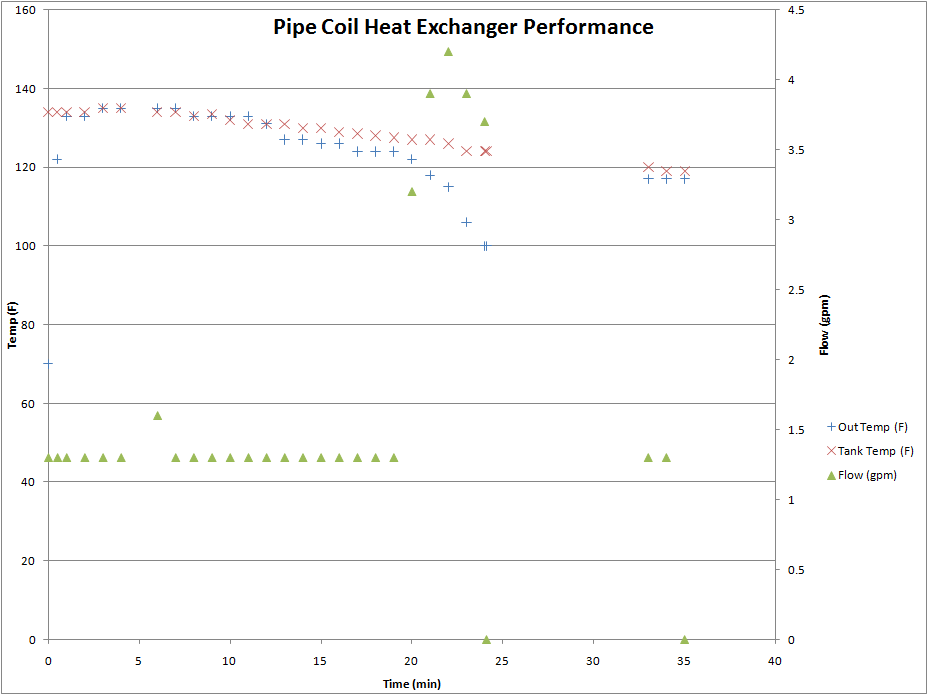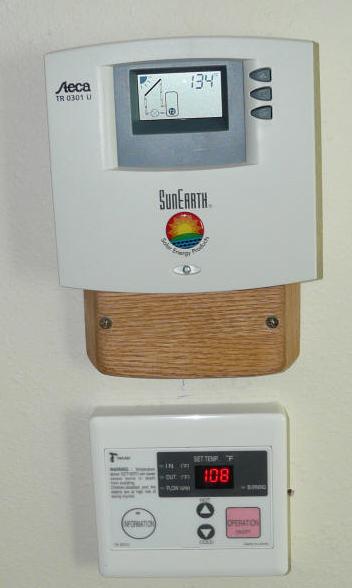
Search
The Renewable Energy site for Do-It-Yourselfers
Performance of
Plastic Pipe-Coil Heat Exchanger
Our solar
water heating system uses a 300 ft coil of 1 inch diameter HDPE plastic pipe
for the heat exchanger. The coil of pipe is immersed in a non-pressurized
water tank that is heated by a solar collector. Cold water enters
one end of the pipe coil, is heated as it goes through the pipe coil by the hot
storage tank water, and comes out the other end preheated. One nice
feature of this arrangement is that the pipe coil itself holds about 12 gallons
of water, and this water will normally be heated up to the full storage tank
temperature at the start of a water draw. Most hot water demands will be
satisfied with this already heated water. Another nice thing about it is
that a 300 ft coil of 1 inch HDPE, NSF approved for potable water can cost as
little as $70.
| |
Updates:
I've since changed from the 300 ft, 1 inch diameter coil of HDPE to a
300 ft, 1 inch diameter coil of PEX. I don't think that the
performance is likely to be measurably different.
The PEX coil allows the tank to be run to a higher temperature for more
heat storage, and I (perhaps imagined) that the HDPE contributed a
little bit of odor to the water when showering.
March 2012: did a longer test with higher flow rates to see how well the
big coil of PEX holds up for the somewhat unusual (but important) case
of very long hot water draws and higher flow rates.
The test results are here...
Gary |
This approach for a heat exchanger
came out working with Nick Pine on the development of
our horizontal pond solar water heater.
Since this is our first real
application of this unique heat exchanger I did the small test below to
characterize its performance for our domestic solar water heating system.
This small test attempts to find out:
-
Does the initial 12 gallons of
water already in the pipe coil come out a full storage tank temperature?
-
After the initial 12 gallons is
used, how good a heat exchanger is the 300 foot pipe coil. That is,
how much is the incoming cold water heated up in one trip through the pipe
coil?
-
How much does the pipe coil HX
performance fall off with very high flow rates?
-
How long after a big water draw
does it take the pipe coil to heat back up to tank temperature for the next
draw?

The reddish X's are the storage tank
temps measured about 1/4 up from the bottom (F)
The blue + marks are the outlet
temperature from the pipe coil heat exchanger (F)
The green triangles are the flow
rates through the pipe coil heat exchanger (gpm)
Test Plan:
Using a typical shower flow rate of
1.3 gpm of hot water (maybe 2 gpm after mixing with some cold), go through this
sequence.
-
Confirm that 12 gallons already
residing in the pipe coil will be delivered at storage tank temperature.
-
See what happens to the pipe coil
outlet temperature once the water that was already in the pipe coil is
replaced by new cold water coming in the pipe coil inlet -- e.g. how does
the pipe coil function as a heat exchanger.
-
Try a high flow rate to see how
much temperature drops.
-
Shut the flow off for a few
minutes, and then turn it back on to see how far the pipe coil recovers back
up to storage tank temp.
-
Now give the dog a bath in all
that warm water left in the bathtub.
The plot above shows the results of
going through the first 4 steps listed just above:
Step 1: Minute 0 to 11 -- initial
water resident in coil:
The pipe coil outlet temperature and
the storage tank temperature are the same because the 12 gallons of water
residing in the pipe coil has been sitting there a while and has warmed to the
same temperature as the storage tank water. Until all the preheated water
in the pipe coil is exhausted, the pipe coil will deliver water at the full tank
temperature. The plot shows this happening as expected.
Step 2: Minute 12 to minute 20 --
pipe coil as heat exchanger:
The water in the pipe coil has been
exhausted, and cold water coming into the inlet end of the pipe coil at 50F is
being heated to about the tank temperature minus 3F in the single pass it makes
through the pipe coil. This is at a flow rate of 1.3 gpm, which is typical
of a shower. It would presumably go along in this mode for a long long
time. During this time periods, and with 1.3 gpm flow, the pipe coil heats
the water from 50F to about 127F with a tank temperature of 130F -- or, about
(127-50)/(130-50) = 96% of the maximum possible -- not so bad.
Step 3: Minute 20 to 25 -- high flow
rates:
The flow is turned up to the maximum available -- around 4 gpm. After a
while, the pipe coil outlet temperature drops significantly. This is
because the there is no hot water already stored in the pipe coil, and the flow
rate is sufficiently larger that it goes through the pipe coil to quickly to be
heated to tank temperature. Even here though, the storage tank is
providing significant heat. The tankless heater under these
circumstances will kick on when its inlet temp drops below the 108F that it is
currently set at. The tankless burner will attempt to heat it so that its
outlet temperature is 108F.
If there had been no flow through the
pipe coil for a few minutes before this high flow rate segment, then the pipe
coil outlet temp would have been right at the tank temp for the first 3 or 4
minutes, and then it would begin to drop significantly.
So, if you have sustained high flow
rates this may not be the best solution, although I suspect it would still be
capable of extracting all the energy in the storage tank.
Minute 25 --
Shut off water flow.
Step 4: Minute 32 to minute 35 --
pipe coil recovery time:
After 7 minutes of no flow, the flow
is turned back on at 1.3 gpm. This is to see how much the pipe coil
temperature which had gone down below 100 F would come back to tank temperature.
The pipe coil outlet temperature appears to be within about 3F of the tank
temperature, so in about 7 minutes it has made an nearly full recovery.
Additional Notes:
All the data from this test was hand
recorded from these sources:
Storage tank temp is as displayed
on the Steca dif cont display
Pipe Coil outlet temp is the from
the Tagaki tankless water heater display (its inlet temperature)
Flow rates are also from the
Tagaki tankless water heater
I've not checked any of these for
accuracy, but the test does not really require very good accuracy.
 |
The Steca differential
controller (top) displays the tank temperature. The tank
temperature sensor is placed about 1/4 of the way up from the bottom of
the tank. The Takagi tankless water heater remote (bottom) will
display the temperature coming into the tankless heater, the temperature
leaving it, and the flow rate through the heater.
Since the temperature coming into the heater is essentially the same
as the temperature leaving the pipe coil HX, this was used for the pipe
coil temperature. The flow rate was used for the pipe coil flow
rate.
Material on the heat exchanger pipe
coil and the storage tank...
Material on the full solar water heating
system...
|
Gary September
26, 2008


